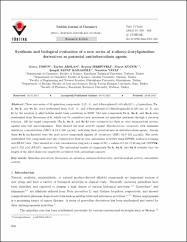Synthesis and biological evaluation of a new series of 4-alkoxy-2-arylquinoline derivatives as potential antituberculosis agents

View/
Access
info:eu-repo/semantics/openAccessDate
2015Author
Tosun, GoncaArslan, Tayfun
İskefiyeli, Zeynep
Küçük, Murat
Karaoğlu, Şengül Alpay
Yaylı, Nurettin
Metadata
Show full item recordCitation
Tosun, G., Arslan, T., İskefiyeli, Z., Küçük, M., Karaoğlu, S.A., Yaylı, N. (2015). Synthesis and biological evaluation of a new series of 4-alkoxy-2-arylquinoline derivatives as potential antituberculosis agents. Turkish Journal of Chemistry, 39(4), 850-866.Abstract
Three new series of 33 quinolone compounds, 2-(2-, 3-, and 4-fluorophenyl)-4-O-alkyl(C5−15) quinolines (7a– k, 8a–k, and 9a–k), were synthesized from 2-(2-, 3-, and 4-fluorophenyl)-2,3-dihydroquinolin-4(1H )-one (4, 5, and 6) by the reaction of alkyl halides under basic conditions in DMF. The new compounds 7a–k, 8a–k, and 9a–k were synthesized from flavonones 4–6, which can be considered new precursors for quinoline synthesis through a one-step reaction. All the target compounds (7a–k, 8a–k, and 9a–k) were evaluated for their in vitro antimicrobial activity against nine test microorganisms. They showed the most activity against Mycobacterium smegmatis with minimum inhibitory concentrations (MIC) of 62.5–500 µg/mL, indicating their potential uses as antituberculosis agents. Among them 8a–k (m-fluoride) were the most active compounds against M. smegmatis (MIC, 62.5–125 µg/mL). The newly synthesized title compounds were also evaluated for their in vitro antioxidant activities using DPPH• radical scavenging and FRAP tests. They showed at a low concentration (mg/mL) a range of SC50 values of 0.03–12.48 mg/mL (DPPH•) and 0–722 µM (FRAP), respectively. The antioxidant results of compounds 7a–k, 8a–k, and 9a–k revealed that the length of the alkyl chain was negatively correlated with antioxidant capacity.

















